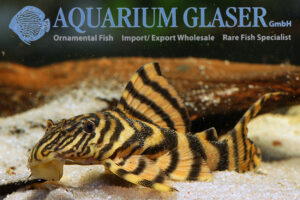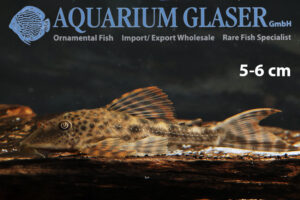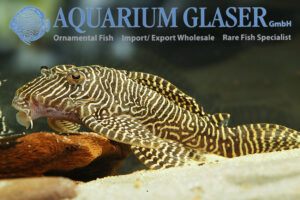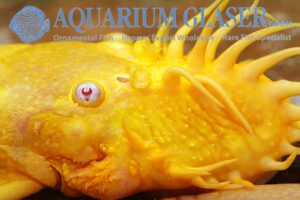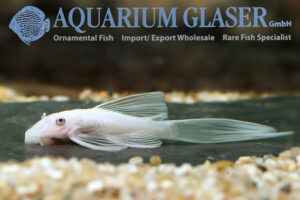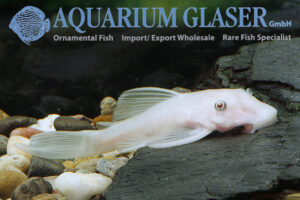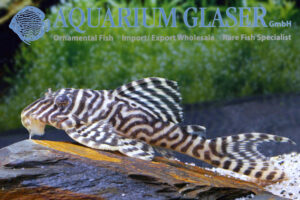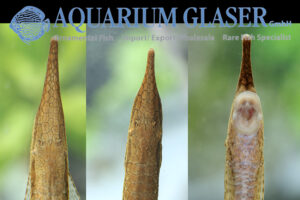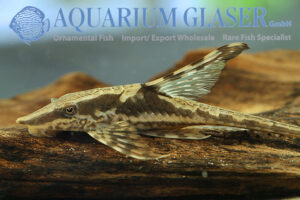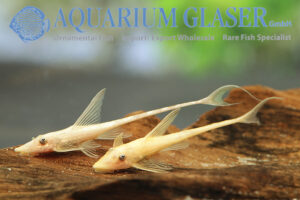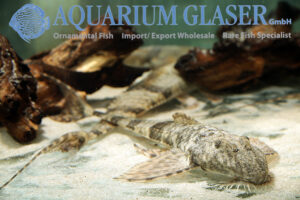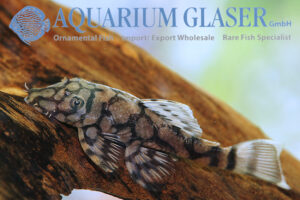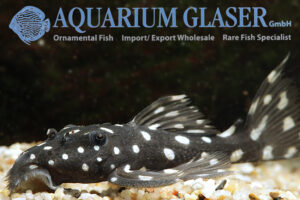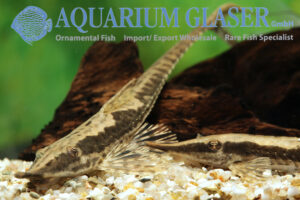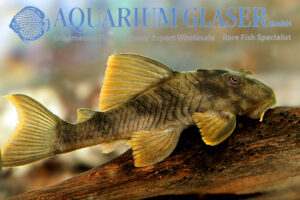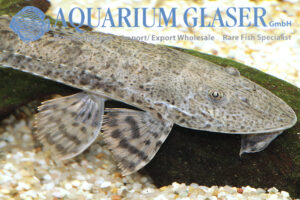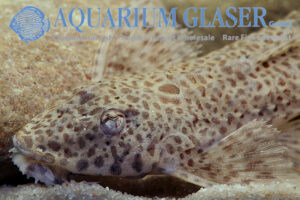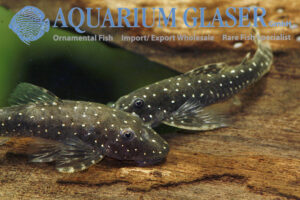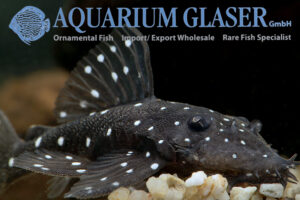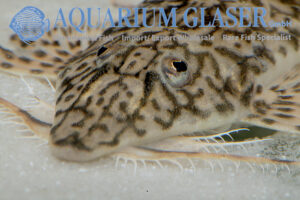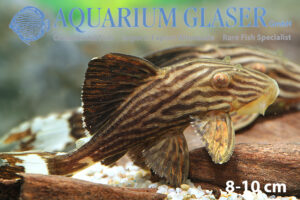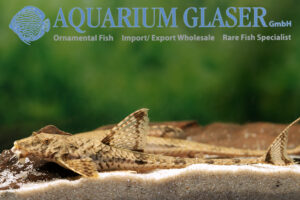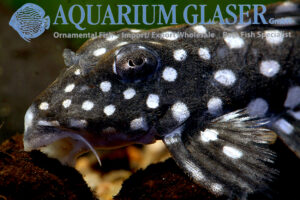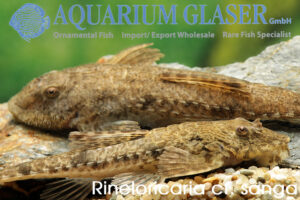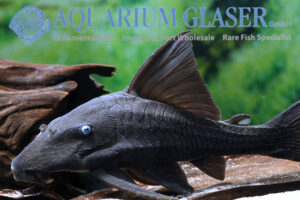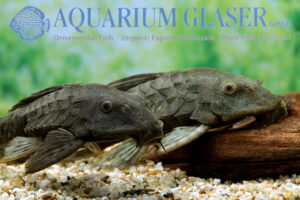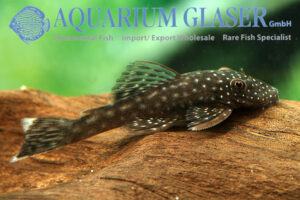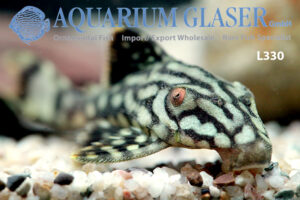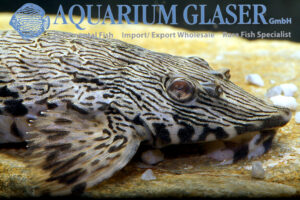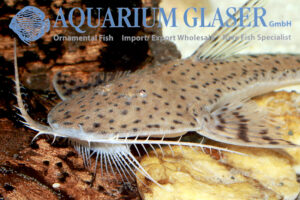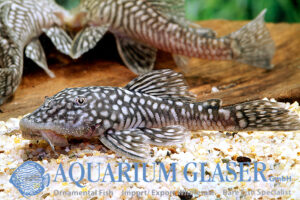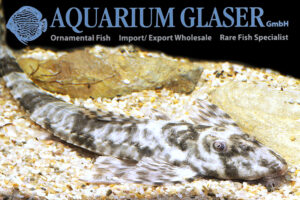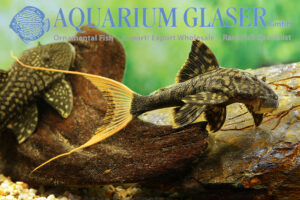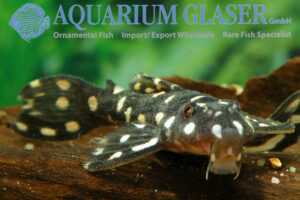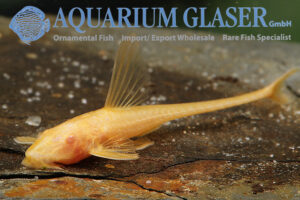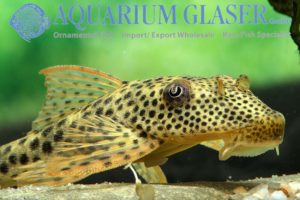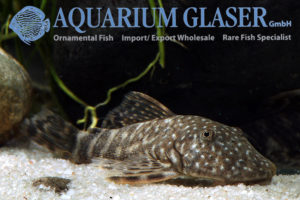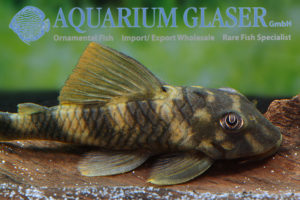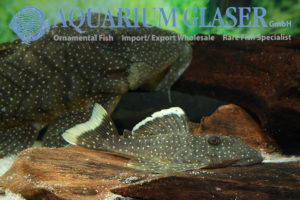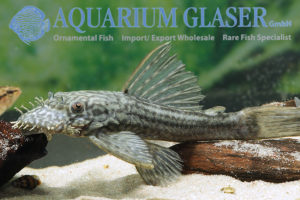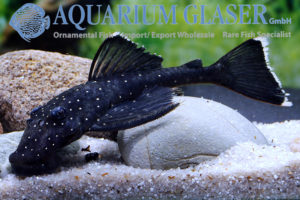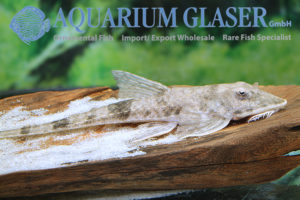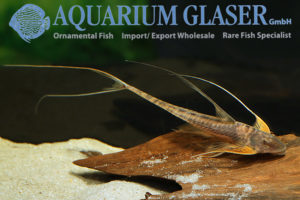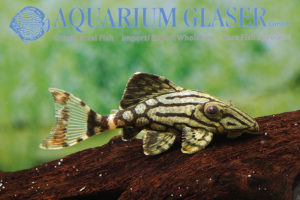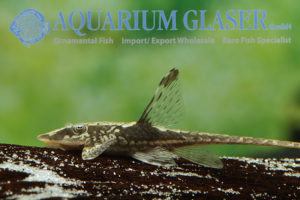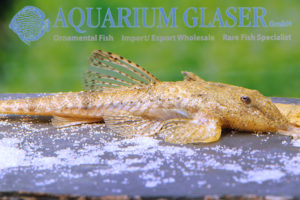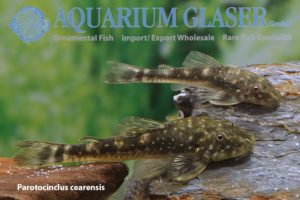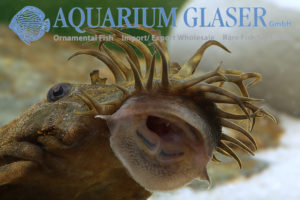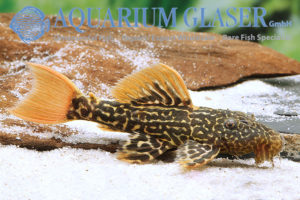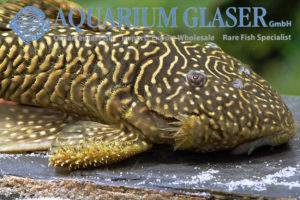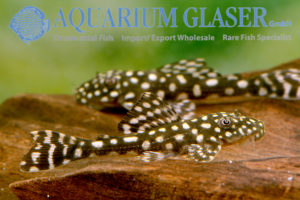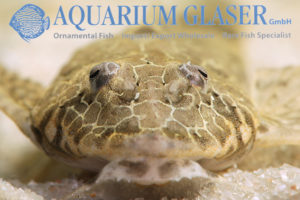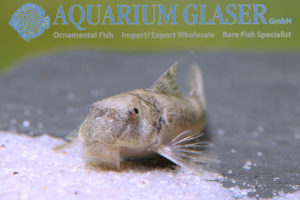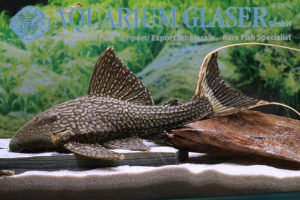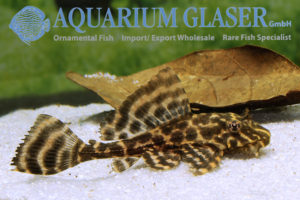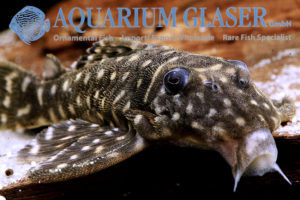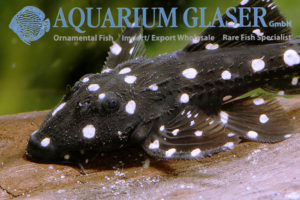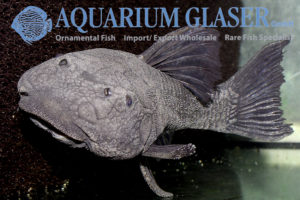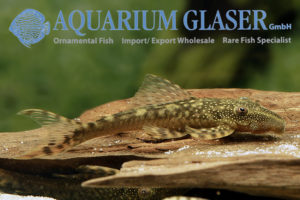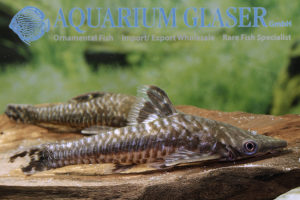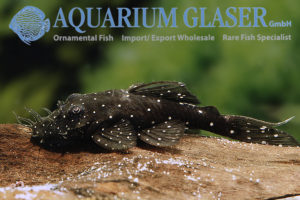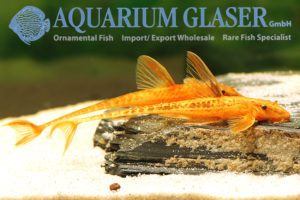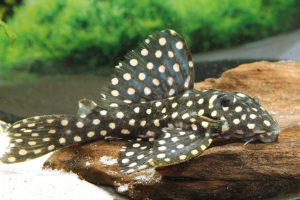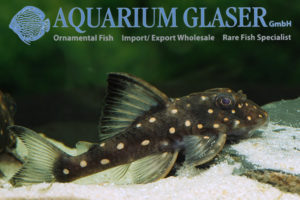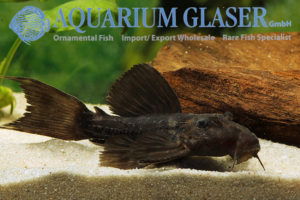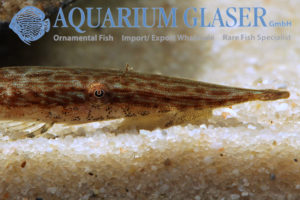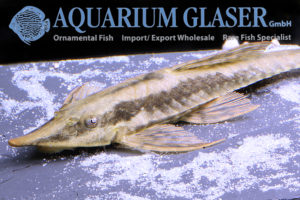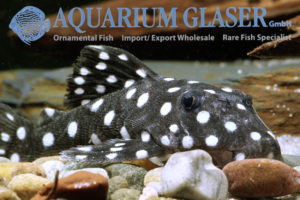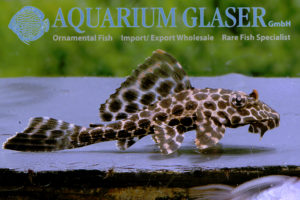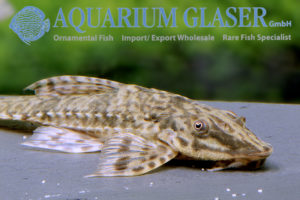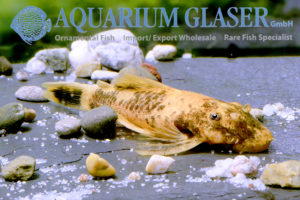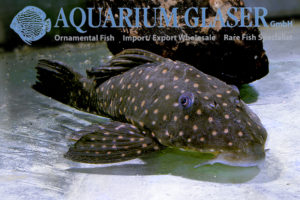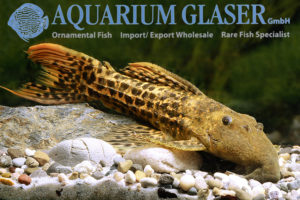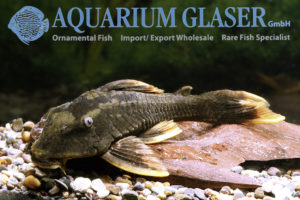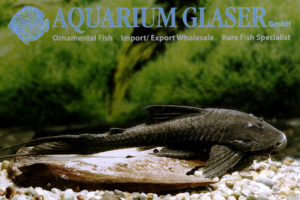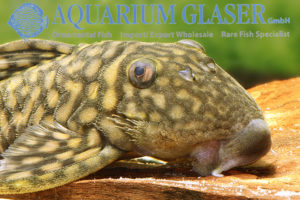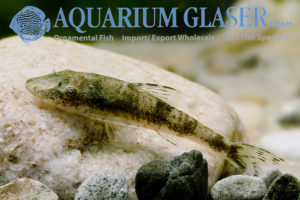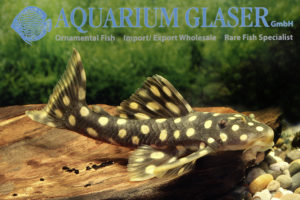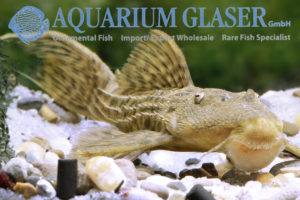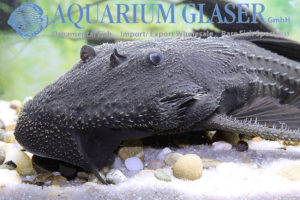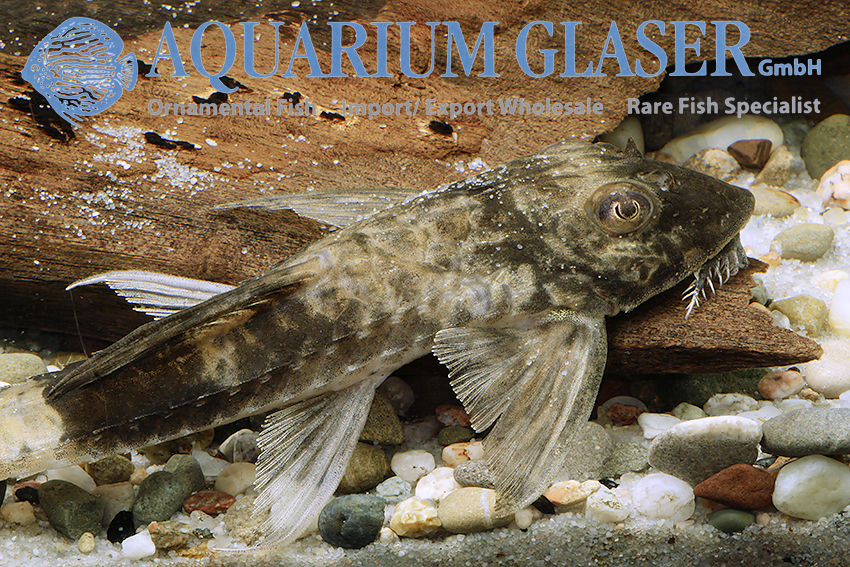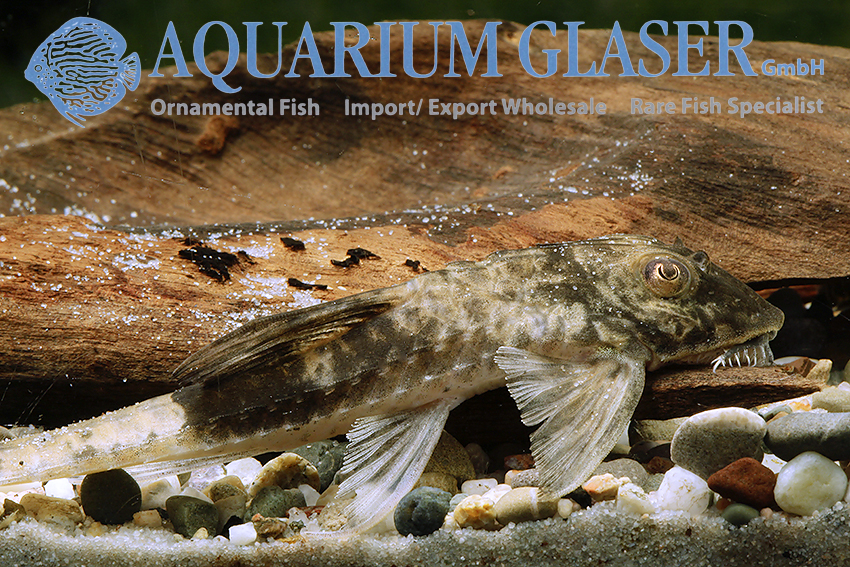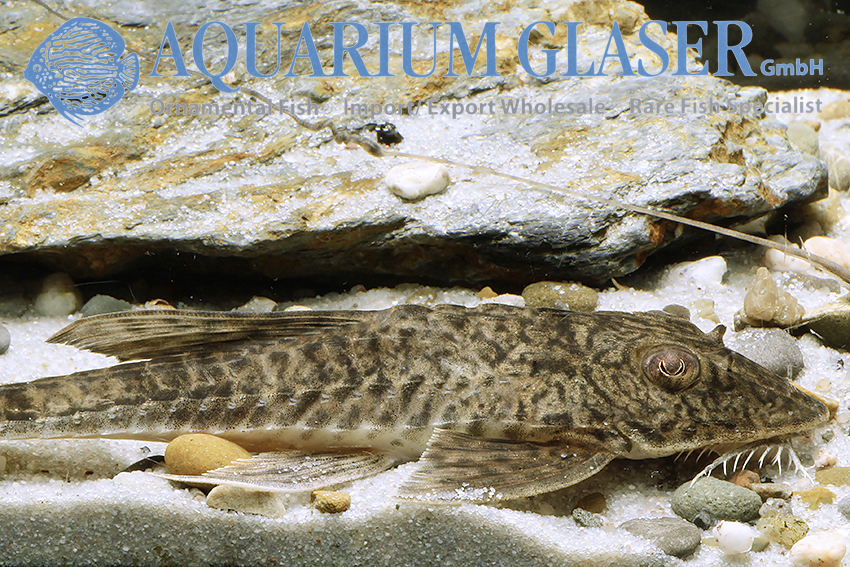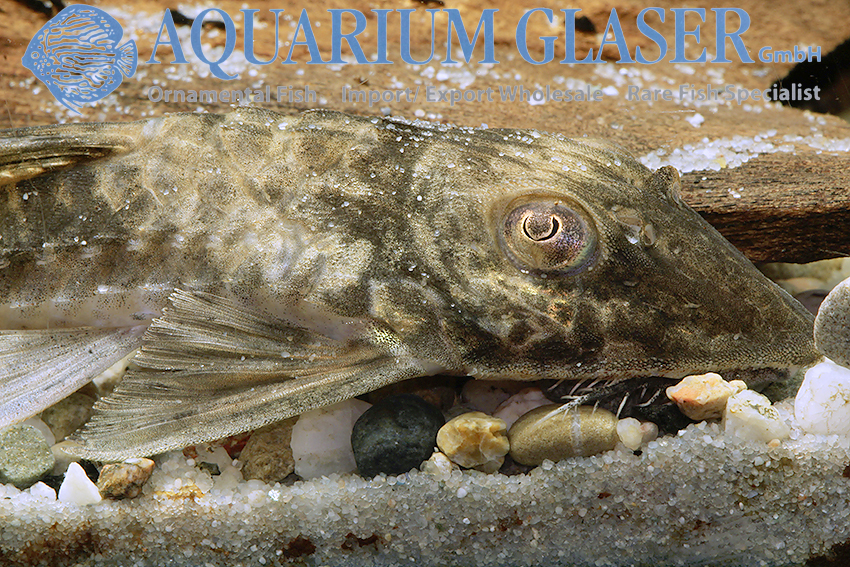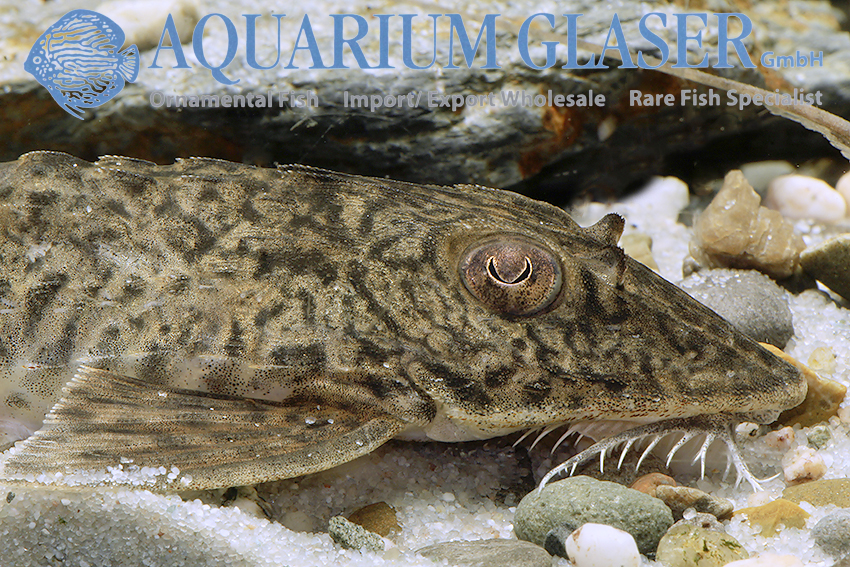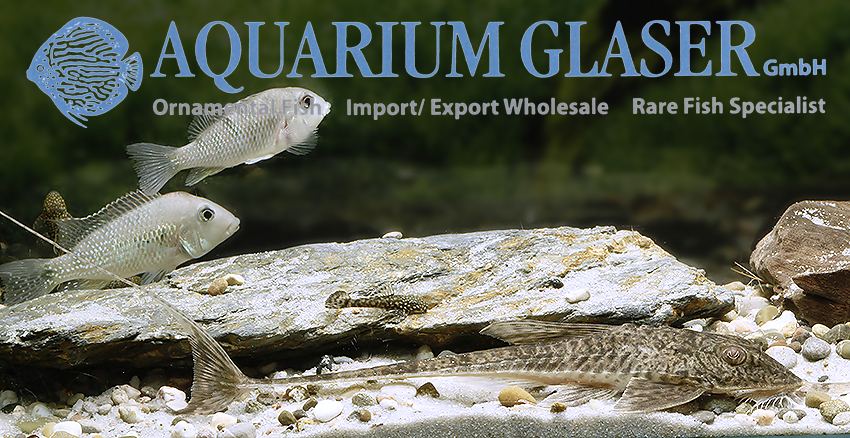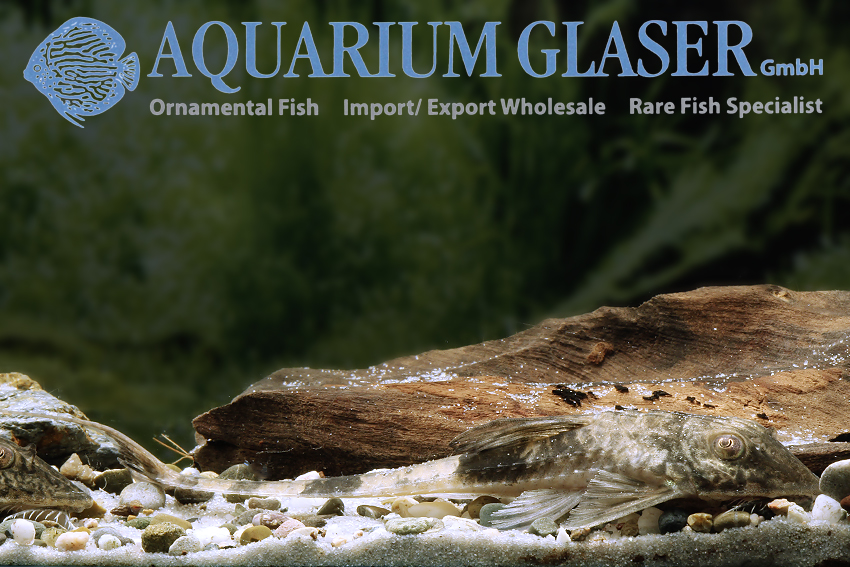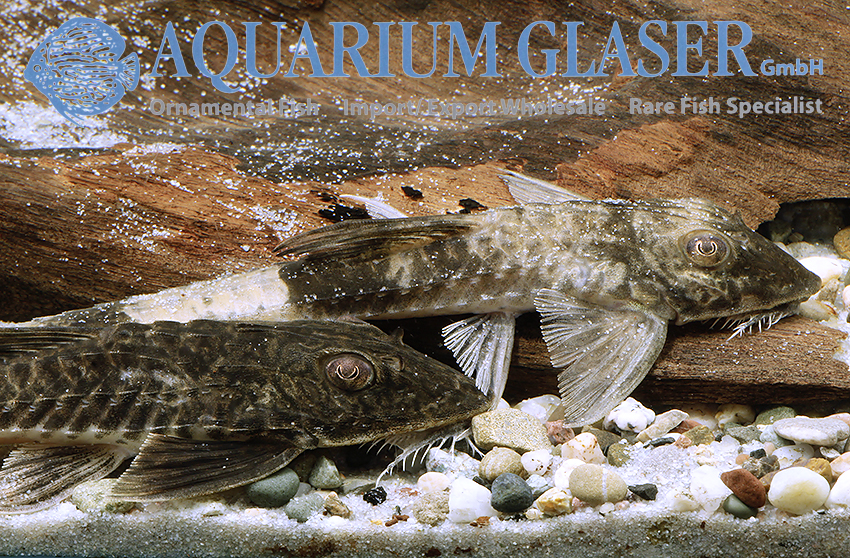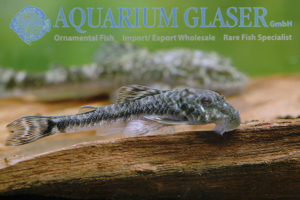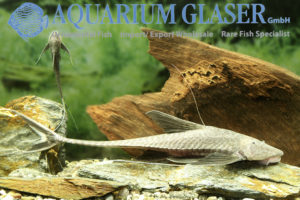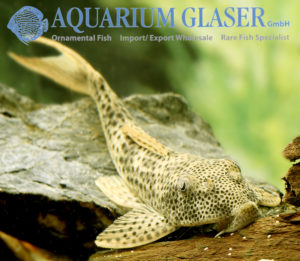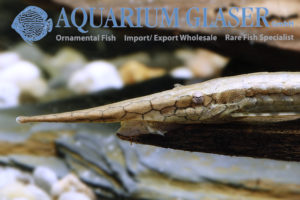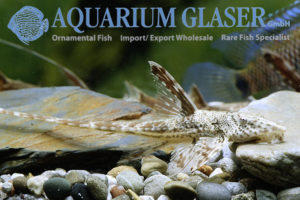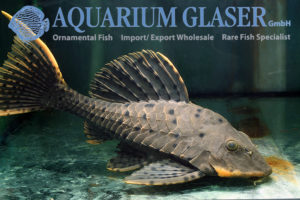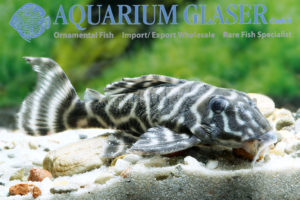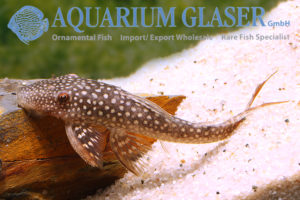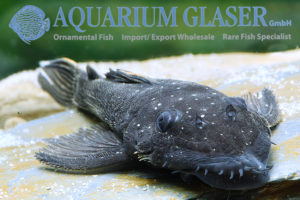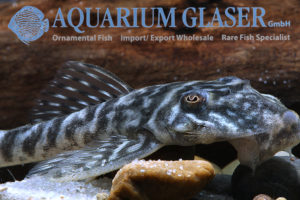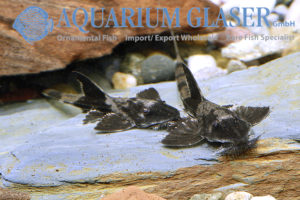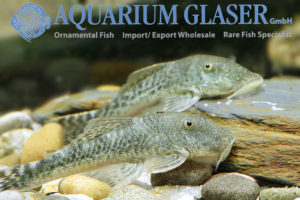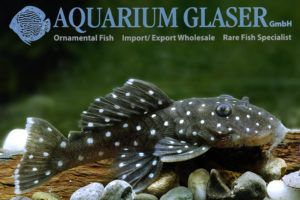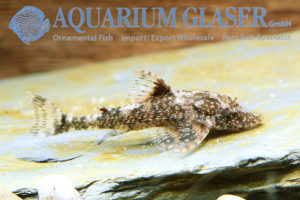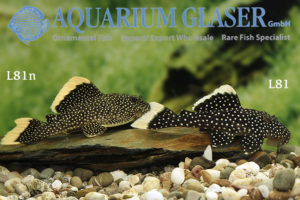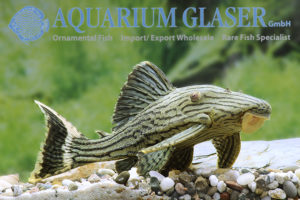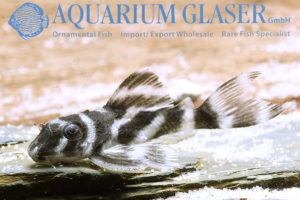There are several tiger plecos of the genus Panaqolus. First L2 was imported from the Rio Tocantins and introduced in 1988 in the very first “L-catfish article” in the Datz. In 1992, LDA1 from the Rio Negro was added, which was given the additional L number 169 in 1994. The tiger pleco presented in 2001 […]
10b. Catfishes: Suckermouths, Plecos and L-numbers (318)
-
-
Hypostomus boulengeri
Every aquarist probably knows the genus Hypostomus by name, to which 154 species are currently assigned (including Cochliodon, which is sometimes seen as an independent genus and sometimes as a synonym of Hypostomus). Of this huge variety, however, only one species is regularly found in the trade, namely Cochliodon basilisko, also known as Red Bruno. […]
-
Hypancistrus sp. L260 Queen Arabesque
It is astonishing that this strikingly colored catfish from the Rio Tapajós in Brazil (state of Para) has not yet been scientifically recorded. Since 1998 it has carried the L-number 260 and since then has also been one of the regularly imported and bred L-catfish. There are great similarities to L411 from the Rio Jari. […]
-
Ancistrus sp. “Gold Albino”
Albinism is a mutation that can occur in almost any animal species, including humans. The word is derived from the Latin “albus” = white. The expression of the mutation is admittedly different. In some forms of albinism, some melanin (the black cell pigment) is still produced, in other forms hardly any or none at all. […]
-
Ancistrus sp. “Snow White Longfin”
When asked: “May it be a little more?”, many Ancistrus enthusiasts answer: “Yes, I’d love to!”. The result is Veil Ancistrus, which are now available in pretty much all colors of the popular aquarium Ancistrus. Of course, the “Snow White Longfin” are still quite exclusive and only available from time to time. There are both […]
-
Ancistrus “Snow White”
White animals – preferably as pure white full albino with red eyes – exert a special attraction on many people. The white coloration gives them the impression of special purity and innocence. It is therefore no wonder that albinos sooner or later appear in the trade from almost all very frequently kept and bred animal […]
-
L66 is now Hypancistrus seideli
The scientific processing of loricariid catfishes with L-numbers is progressing. The confusing variety of forms that some species develop is a problem that is almost impossible to solve, even for ichthyologists, i.e. professional fish experts. In a recent study, a team of scientists looked at two Hypancistrus species from the Rio Xingu, namely L174, which […]
-
Farlowella hahni
The needle catfish (Farlowella) are whimsical representatives of the loricariid catfishes (Loricariidae), reminiscent of sticks. They graze on fine growth with their typical sucking mouth. They are usually common animals in the wild, which is why they attracted the attention of scientists early on. The first species was described in 1853 (F. acus), the last […]
-
Sturisomatichthys aureus
As is well known, the royal farlowellas (Sturisoma and Sturisomatichthys) were reclassified in 2019, resulting in some regrouping. Several species previously classified as Sturisoma now belong to the genus Sturisomatichthys. According to Londoño-Burbano & Reis, 2019, externally recognizable differences between the two genera are the irregular, numerous central ventral plates that are not arranged in […]
-
Sturisomatichthys ALBINO
As is well known, the royal farlowellas (Sturisoma and Sturisomatichthys) were reclassified in 2019, resulting in a number of regroupings. Several species previously classified as Sturisoma now belong to the genus Sturisomatichthys. According to Londoño-Burbano & Reis, 2019, externally recognizable differences between the two genera are the irregular, numerous central ventral plates that are not […]
-
Oxyropsis acutirostris
Unfortunately, the “Giant Otos” of the genus Oxyropsis are rarely offered for sale. Three species are currently scientifically accepted, O. carinata and O. wrightiana, which inhabit the upper and middle Amazon basin, and O. acutirostris from the upper Orinoco and Rio Negro basin. Oxyropsis can be distinguished from the similar species of the genus Hypoptopoma […]
-
Spatuloricaria terracanticum ( = S. sp. COLOMBIA)
The genus Spatuloricaria consists of 13 scientifically described species. The genus has an extremely wide distribution area from the south of South America (Argentina, Paraguay, Uruguay, southern Brazil) to Panama in the north. It is also found on both slopes of the Andes. 11 of the 13 species were described by 1945, with two new […]
-
Ancistrus sp. L519 Bolivia
During the private fish expedition “SiluCha 2018”, this Ancistrus, which is ideal for aquariums, was discovered in the drainage of the Rio Iténez. The collectors managed to bring back a few specimens and breed them. In the meantime, this beautifully marked species has even reached the trade, and because there are currently no professional ornamental […]
-
Leporacanthicus sp. L241
Why do so many L-catfish have a light-colored dot pattern on a black background? From the 3-5 cm long Parotocinclus haroldoi (https://www.aquariumglaser.de/en/fisharchive/parotocinclus-haroldoi-4/) to the sometimes meter-long Acanthicus adonis (https://www.aquariumglaser.de/en/10-catfishes/acanthicus-adonis-2/) the coloration occurs; in between there are tens of species with such coloration, which are in between in size. In the entire realm of other catfish, […]
-
Sturisoma cf. ghazziae
Recently (December 2023) the genus Sturisoma was revised and on this occasion four new species were described. We have now been able to import Sturisoma from Brazil and according to the identification key of the revision we came to the conclusion that it must be one of the newly described species, namely Sturisoma ghazziae. This […]
-
Peckoltia sp. L76
In 1990, well over 30 years ago, the beautiful orange-fringed loricariid catfish L76 was introduced in the DATZ. Like L99, which was introduced in 1992 and is currently only seen as a color variant of L76, it originates from the Brazilian state of Pará, more precisely from the Rio do Pará. There are three forms […]
-
Loricariichthys sp. Rio Blanco
The interesting genus Loricariichthys currently comprises 19 accepted species. The members of the genus can be reliably recognized by the shape of their lips. These lip-brooding catfishes – similar to many other whiptail catfishes, the male carries the clutch of eggs attached to the lower lip until the larvae hatch – do not have any […]
-
Rineloricaria formosa ( = Hemiloricaria f.)
Among the small whiptail catfish (Rineloricaria), all of which are cave breeders, there is a group that is particularly well adapted to life on sandy bottoms in black water. They are particularly sought after by catfish specialists due to their attractive spot pattern. What they have in common is a circular, conspicuous spot on their […]
-
Parotocinclus haroldoi
Perhaps the prettiest and at the same time most suitable otocinclus for aquaristics is Parotocinclus haroldoi. Concerning the coloring – yellow-white, shining spots on black underground – the species resembles the adonis pleco (Acanthicus adonis), remains however with maximally 4 cm (male) and at all-highest 5 cm (female) much, much smaller. Until now this species, […]
-
Ancistrus sp. L107
One of the most beautiful Ancistrus of all is certainly L107, which – as far as we know – has still not been scientifically studied. It is a pitch-black Ancistrus with snow-white spots, which is also known as the “brilliant Ancistrus” due to its striking contrast. In contrast to many other similar Ancistrus, this species […]
-
Rhadinoloricaria andaki
It’s been a while – April 2016 – since we were able to proudly report the first import of a Rhadinoloricaria species from Venezuela. Although the genus was already described in 1974, the only species assigned to it in 2016, R. macromystax from Peru, is considered to be very rare. Since our first import, the […]
-
L27 Xingu Panaque cf. armbrusteri
The fine systematics of the large (over 30 cm) black-striped Panaque is still only unsatisfactorily studied. Panaque nigrolineatus (L190) from Colombia and Venezuela is certainly the best known by name, and in 2020 a subspecies, usually rather spotted, was described from the upper Rio Guaviare in Colombia (P. n. laurafabianae, L330 see https://www.aquariumglaser.de/en/10-catfishes/l330-scientifically-described-panaque-nigrolineatus-laurafabianae/). Aquarists recognized […]
-
Rineloricaria eigenmanni
There is no consensus among ichthyologists (= fish experts) as to the correct generic name for the whiptail catfish of the narrower Rineloricaria relationship. Some group all species together as Rineloricaria, others divide these fish into Rineloricaria and Hemiloricaria. Rineloricaria in the broadest sense is very species-rich, currently 64 species are recognized and there are […]
-
Hypancistrus inspector “L102, Snowball Pleco”
L102 is one of the plecos that has long been known in the hobby and was given its L number back in 1992. These animals originated from the lower Rio Negro in Brazil and were soon given the popular name “Snowball Pleco” because of the large white spots on a black background. The species was […]
-
Rineloricaria cf. sanga
We received Rineloricaria from the Brazil-Uruguay border region. The genus Rineloricaria is extremely species-rich with currently 72 accepted species and new species are constantly being added. Unfortunately, there is no complete overview of the genus, making identification extremely difficult. The southern Rineloricaria are also particularly tricky because only a few live observations have been made […]
-
Panque suttonorum ( = P. suttoni)
In the 1980s, the blue-eyed Panque was one of the most common loricariid catfishes on the market. Incidentally, the correct name is Panaque suttonorum. For unknown reasons, the animals are hardly available nowadays. There are a lot of rumors that an environmental disaster is to blame or that a madman has poisoned the river or […]
-
Pseudorinelepis sp. L95a
At present, only one species of Pseudorinelepis is recognized by scientists, namely P. genibarbis. According to this assumption, the species is widely distributed in tropical South America and occurs in the Amazon and its tributaries as well as in the Orinoco and its catchment system. According to this theory, the color differences observed in living […]
-
Ancistrus sp. LDA45 / L349
Hardly any other genus of loricariid catfish, often referred to as L-catfish, is as widespread and important in aquariums as Ancistrus. Practically every aquarium is home to a few of these problem-free animals, which do an excellent job of cleaning the glass, look bizarre and hardly disturb other fish. But when it comes to identification […]
-
Panaque from Colombia: L190, L191, L330
We can currently offer all three striped Panaque from Colombia, namely L330 Panaque nigrolineatus laurafabianae (Colombia: upper Rio Guaviare drainage), L190 Panaque nigrolineatus nigrolineatus (Colombia/Venezuela: Rio Meta and lower drainage of the Rio Guaviare) and L191 Panaque cf. titan (Colombia: Rio Caguán, drainage of the Rio Caqueta). We have comparable sizes of all three forms […]
-
Rineloricaria sp. Jacareacanga
We have received a small number of these new, really unusually marked Rineloricaria sp. Jacareacanga – named after the place where they were found on the Rio Tapajós. Many thanks to Ingo Seidel for the information on the origin of these catfish! Our largest animals are about 15 cm long. They are real beauties, who […]
-
Planiloricaria cryptodon
Currently we have wonderful flounder whiptail catfish from Peru in stock. They are currently 10-13 cm long. These sizes give only the body length, as in Planiloricaria there is a filament on the upper lobe of the caudal fin that is as long as the body! Maximum length given in literature is 35 cm. Nevertheless, […]
-
Pseudancistrus genisetiger
This beautiful loricariid catfish was already scientifically described in 1941. The type locality is the drainage of the Rio Jaguaribe in the Brazilian state of Ceará in the north-east of the country. The maximum length published to date is around 13 cm (10 cm without caudal fin). The Rio Jaguaribe is notorious for its erratic […]
-
Spatuloricaria sp. „Black-White Peru“
The genus Spatuloricaria comprises currently 13 accepted species. Members of this genus are large, splendid whiptail cats. There is probably no species that stays smaller than 30 cm in length, some become definitely larger. This means that the fish have to be kept in large aquaria. Spatuloricaria are sensitive against poor water quality. Thus a […]
-
L90a Panaque bathyphilus
The large, wood-eating Panaque species have their loyal fans. Although these animals only reach us in relatively small numbers, they have been on offer from exporters for decades. This includes L90, the variably colored Panaque bathyphilus from Peru, which can easily reach a body length of 60 cm in old age. We have reported on […]
-
Scobinancistrus raonii L82 ( = “Scobinancistrus sp. Orange Spot”)
The beautiful L82 originates from the lower Rio Xingu in Brazil (around Altamira). The species is very variable in terms of spot size and shape. Wild-caught specimens also often have a yellowish-orange spot coloration or shiny green-blue spots (“Opal-Pleco”). A few days ago (on October 30, 2023), the species, which received its L-number back in […]
-
Rineloricaria lanceolata “Albino“
Albinism, i.e. the complete or partial absence of black color pigments in the body cells, occurs widely as a mutation in the animal kingdom. While albinos rarely survive in the wild because of their striking light color, they are particularly popular in commonly bred animals. On many people albinos seem very attractive. The species Rineloricaria […]
-
Squaliforma cf. emarginata L11
Among the loricariid catfishes that are known by scientists for a very long time already is this species. It has been described initially 1840 under the name of Hypostomus emarginatus. Since then it has been placed in different genera, in 2001 in Squaliforma and in 2016 in Aphanotorulus, when Squaliforma has been considered to be […]
-
Chaetostoma dorsale (L147, L443)
The bristlemouth catfish (Chaetostoma) are an exceptionally diverse genus of suckermouth armored catfishes. According to Fishbase (2023), 47 species are currently considered valid. From Colombia, more precisely from the surroundings of the city of Villavicencio, the capital of the department of Meta, Chaetostoma have been exported for decades as common “bread-and-butter fish”. However, it was […]
-
Peckoltia sp. L265/LDA84
There are three forms of orange fringed plecos among L catfishes, namely L76 (tributaries of Rio do Pará, Brazil), L99 (also tributaries of Rio do Pará, Brazil), and L265 (Rio Tajajós and its tributary Rio Jamanxin, Brazil). Thus, all sites are located within the state of Pará. L265 has also received LDA number 84 after […]
-
Baryancistrus xanthellus L81c Sao Felix
The great hype surrounding L catfish has long since given way to normal handling of these beautiful and interesting fish. One of the enduringly popular species is Baryancistrus xanthellus, which entered the hobby under L numbers L18, L81 and L177. The species is common and frequent in the Rio Xingu and its tributaries. Nevertheless, it […]
-
Ancistrus sp. L 267 Pozuzo
The “four-striped Ancistrus” L267 is still a somewhat mysterious species. Even if the first specimen became known already in 1996, this Ancistrus always remained a top rarity in the trade and was not available at all for years. Even the origin remained unknown until now. We get the fish from an exporter in Peru, who […]
-
Pseudolithoxus nicoi
We could import some specimens of the pretty white fringed flying catfish Pseudolithoxus nicoi from Venezuela. This very rarely available species grows to a length of about 12 cm. P. nicoi originates from the Rio Casiquiare, which connects the Rio Negro with the Orinoco. There is great similarity to P. anthrax (L235), which is why […]
-
Loricaria luciae
From Paraguay we received a nice shipment of mouthbrooding whiptail catfishes (Loricaria). Because of the known difficulties to identify species in Loricaria exactly, we first named them provisionally as L. simillima, the aquaristic best known species of the genus, which also occurs in Paraguay. Now that the animals are somewhat acclimated and also the latest […]
-
Lamontichthys filamentosus
From Peru we could import some Lamontichthys filamentosus. This graceful, beautiful species reaches a body length of about 20 cm, the fin filaments can become even that long. Lamontichthys are very sensitive fish, which need optimal water conditions. In addition, the fish are often difficult to bring to the food. Obviously they are very shy […]
-
Panaque sp. L191
The large wood-eating Panaque of the relationship around P. nigrolineatus are fantastic fishes. Juveniles are almost splendidly colored, so also L191, a species which is still not described scientifically. L191 originates from Colombia. According to the available information the native area is the Rio Caguán in Caquetá. Particularly splendid is with young L191 the green […]
-
Sturisomatichthys sp. Colombia II
The whiptail catfishes belong to the popular and well breedable loricariids. For example, the Real Royal Farlowella (Sturisomatichthys festivus) has been in continuous breeding for almost 50 years, wild catches of this species are very rare. For other species, wild catches and offspring coexist in the hobby. In former times Sturisomatichthys was considered to mainly […]
-
Soon available: Rineloricaria aurata
From Paraguay we regularly receive shipments of the small whiptail catfishes of the genus Rineloricaria. No less than 65 species are currently recognized, which makes identification in many cases almost impossible without knowledge of the origin. But in the case of Paraguay, there is a recent revision of the species known from this river system […]
-
Parotocinclus bahiensis and P. cearensis
The genus Parotocinclus currently exists in a kind of shadowy existence in aquaristics. In contrast to their cousins of the genus Otocinclus, hardly anyone knows these equally small loricariids, which are, however, equally zealous algae exterminators. We have received from the Northeast region (Região Nordeste), more precisely from the states of Cereá and Bahia of […]
-
Ancistrus sp. Bushmouth LDA 72
Ancistrus species belonged to aquaristics long before one even thought of the term L or LDA number. Unfortunately, the systematics of the group is complex, there have been and still are misidentifications and – this is especially unfortunate – the species can apparently often be crossed, so that aquarium hybrids have been created unintentionally. Such […]
-
Pseudacanthicus sp. L600
We have received fantastic leopard cactus plecos L600. They are german bred ones. One specimen is as beautiful and flawless as the other! We are extremely enthusiastic about the quality of the animals. They are currently 6-8 cm long. For our customers: the fish have code 26480-L 600-2 on our stocklist. Please note that we […]
-
Parancistrus sp. Rio Araguaia L56n / LDA46
The genus Parancistrus includes only two scientifically accepted species, the Golden Parancistrus (P. aurantiacus), which was erroneously also assigned L-number 56 (this is incorrect) and P. nudiventris, which was assigned L-numbers 31 and 176; this is a black catfish with very fine white spots. In addition, we know L258 from Rio Iriri, a black catfish […]
-
Hypostomus sertanejo
For the first time we can offer this very nice Hypostomus from the Rio Jaguaribe (Cerea State, Brazil). It is a species that was described scientifically only in 2017, although 19 specimens of this species were found in the scientific collection of the Academy of Natural Sciences of Philadelphia, U.S.A., which had been collected and […]
-
Rineloricaria teffeana
The small remaining whiptail catfishes of the genus Rineloricaria enjoy great popularity among aquarists. They have a whimsical appearance, are peaceful, have no high space requirements and can usually be bred quite well. Some species have even really fancy pattern. The most beautiful is certainly R. teffeana. It has no bright colors, but a really […]
-
Parotocinclus jumbo LDA25, now available as German bred!
The cute Parotocinclus jumbo, also known as Pitbull Pleco or LDA25, is a very popular aquarium fish. Unfortunately imports take place only very irregularly and can hardly be planned. Therefore we are happy to be able to offer this nice little fish as offspring now. More information about the species can be found here: https://www.aquariumglaser.de/en/fish-archives/lda25-parotocinclus-jumbo-2/ […]
-
L90a Panaque bathyphilus
The large-growing, magnificent Panaque bathyphilus is very variable in coloration. We have at present quite splendid 16-20 cm long animals in stock. With this they are about half grown, as maximum length for P. bathyphilus about 60 cm are given. It goes without saying that these large fish should only be kept in large aquariums. […]
-
Glyptoperichthys parnaibae
For the first time ever we can offer Glyptoperichthys parnaibae, so far known exclusively from the Rio Parnaiba in Brazil. The Rio Parnaiba is located in the northeast of Brazil and has a high proportion of endemic, i.e. only there occurring fish species, because there is no connection to other river systems. The juveniles of […]
-
L129 var Hypancistrus debilittera
The small remaining, nicely marked Hypancistrus debilittera from the Rio Bita (a tributary to the Rio Meta, Colombia, Orinoco drainage) enjoys a great popularity since years. Already with 7 cm length the males become sexually active, the maximum length is given with about 12 cm. We import this species regularly. Recently we received a “Hypancistrus […]
-
Acanthicus adonis
Now it is season again for one of the most beautiful of all loricariid catfishes: Acanthicus adonis. The species name “adonis”, which is reminiscent of the ancient god of beauty and vegetation, Adonis, is aptly chosen. For like the god described as a beautiful youth, the Adonis catfish is such a beauty only when young. […]
-
Rhinelepis cf. strigosa
The two species of the genus Rhinelepis – R. aspera and R. strigosa – belong with over 60 cm attainable final size to the largest armored catfishes at all and are therefore predestined as show objects in zoos, public aquariums and of course also for owners of gigantic private aquariums. Color-wise they have nothing to […]
-
L92/L194 Lasiancistrus tentaculatus
There seems to be a consensus among armored catfish enthusiasts that L92, which is very widespread in the Orinoco drainage of Colombia and Venezuela and later received another L-number, namely L194, is identical to Lasiancistrus tentaculatus, which was described in 2005. However, L. tentaculatus is described as more or less monochromatic brown, while L92 is […]
-
Hypoptopoma sp. Ucayali
From Peru we could import very nice Hypoptopoma. Most of the import consisted of H. gulare (see https://www.aquariumglaser.de/fischarchiv/hypoptopoma-gulare/), but there were some specimens with very conspicuous, broad bands in the dorsal fin and contrasting caudal fins. Unfortunately the identification attempt based on the current revision of the genus (Aquino & Schaefer, 2010) did not give […]
-
Ancistrus sp. L184 (= L107)
One of the most attractive Ancistrus species is this so far not scientifically identified species from the middle Rio Negro in Brazil. There the beautiful fish is not rare, in some places even very common, but the species apparently prefers biotopes which are avoided by the local fishermen; otherwise it can hardly be explained why […]
-
Rineloricaria lanceolata “Red Dun“
For the first time we can offer the breeding form “Red Dun” of the Chocolate Whiptail Catfish. This new breeding form goes back to a wild-caught male that we were able to import from Paraguay in November 2015 (see https://www.aquariumglaser.de/en/fish-archives/rineloricaria_lanceolata_en/). We gave it, together with some normal females of the same import, to our breeder […]
-
Hypancistrus contradens L201a Big Spots
From the lower Rio Ventuari in Venezuela – the largest tributary of the Orinoco – as well as from the Orinoco itself in the Ventuari estuary comes a beautiful Hypancistrus. It has large, bright spots on a deep black ground. The coloration of the spots is varying between shy white and orange-pink. There is a […]
-
L501 Hypanacistrus sp. Mitu
Snowball plecos belong to the largest Hypancistrus species. They can reach up to 20 cm in length. Members of the group are easily recognized by the conspicuous black fringes in the dorsal and caudal fins. Distinguishing the aquaristically known form, on the other hand, is tricky and sometimes simply impossible without knowledge of the origin. […]
-
Pseudacanthicus sp. L185 Bred
The cactus plecos (Pseudacanthicus) are popular with owners of large aquariums. L185 originates from the Rio Xingu and is also called Belo Monte Cactus Pleco, because this catfish used to be caught there. We do not know if the species still exists there, or if it was wiped out by the construction of the Belo […]
-
Acestridium dichromum
The strange sucking catfishes of the genus Acestridium – there are currently seven recognized species in the genus – could also be called “dwarf needle catfishes”, because they look like a miniature version of the needle catfishes of the genus Farlowella. Unfortunately, these animals are still an aquaristic challenge, which only very experienced aquarists should […]
-
The sturgeon catfishes of Paraguay: Sturisoma barbatum or S. robustum?
From Paraguay wonderful, partly very large sturgeon catfishes (Sturisoma) are imported. Two Sturisoma species are known from the Rio Paraguay: S. barbatum, described already in 1853 by Kner, and S. robustum, described in 1904 by Regan. The two species differ from each other only insignificantly. The most important anatomical feature distinguishing the two species is […]
-
Baryancistrus sp. Snowflake LDA 33 / L142
This beautiful loricariid catfish comes from the Rio Tapajós in Brazil. Usually, 4-5 cm long youngsters are imported from these catfishes, which look very attractive with their large, white dots on a deep black ground and fully deserve the name “Snowball-Pleco”. In addition to high water temperatures (not below 28°C), these catfishes should be kept […]
-
Glyptoperichthys gibbiceps
The red highfin sucker is a classic, which found its lovers long before the invention of the L-numbers. Juveniles are really adorable and excellent algae killers. In addition they look very beautiful. Since this catfish easily grows to 30-40 cm in length, there are two camps among aquarists. Some are critical of the animal because […]
-
Rineloricaria parva
From Paraguay we regularly receive shipments of the small whiptail catfishes of the genus Rineloricaria. No less than 65 species are currently recognized, which makes identification in many cases almost impossible without knowledge of their origin. But in the case of Paraguay, there is a recent revision of the species known from this river system […]
-
Ancistrus Orange Brown “LDA16”
This extremely attractive Ancistrus is a breeding form. The actual LDA 16 is a wild form imported in 1994 from Brazil (Rio Puraqequara, a tributary of the Rio Guamá, which in turn is a tributary of the Rio Tocantins) and is uniformly purple-brown in color. We do not know if the orange-blotched Ancistrus descended from […]
-
Hypostomus roseopunctatus L311
Not less than 148 species are counted to the genus Hypostomus, but no five of them appear more often in the trade. Special is of course H. luteus with its sail-like dorsal fin and the bright yellow coloration, but most species are “plecos”, brown or gray with black spots. In addition, most species grow quite […]
-
Pseudacanthicus sp. L273 Titanic
The magnificent cactus catfish L273 Titanic, up to 30 cm long, originates from the Rio Tapajós. Its first import in 1998 was a sensation. Interesting about the animals, which are allowed to be exported from Brazil again since some time, is the very individual body pattern. All cactus catfishes are carnivores; towards non-species fishes they […]
-
Cochliodon sp. L360
We have received some beautifully marked yellowseam catfish. This catfish originates from the middle Rio Jamanxin in Brazil and has not yet been correctly (i.e. scientifically) identified, neither in terms of genus nor in terms of species. However, it is quite possible that this catfish has already been scientifically described; young animals are quite inconspicuous, […]
-
L350 Panaque sp. Black Lyretail
From Peru we received four specimens of a top rarity: L350. This peculiar fish does not fit any genus of loricariid catfish known to date. It originates from deep, turbid, very fast flowing water of the Peruvian Amazon, where it can only be caught with great difficulty and rarely. It is a carnivorous species whose […]
-
Spectracanthicus (= Oligancistrus) zuanoni L 354
Spectracanthicus zuanoni L 354 originates from Rio Xingu and the Rio Iriri in Brazil. It has been described scientifically only in 2014 (see http://www.aquariumglaser.de/en/archiv.php?news_id=1195). The fish belongs to the same species as L 20, with however clearly larger white marks, so that the design reminds of a black net on a bright background. The reddish, […]
-
Curculionichthys sabaji
A very long name for a very small fish! The genus Curculionichthys was established only in 2015 to accommodate dwarf sucker catfishes of the subfamily Hypoptopomatinae (formerly: Otothyrinae) of Loricariidae, which were previously placed in the genus Hisonotus. Both anatomical and molecular data showed that two independent evolutionary lineages existed within Hisonotus, namely that around […]
-
Ancistrini sp. L82
Among the species threatened by the construction of the Bela Monte Dam is L82, a species of loricariid up to about 15 cm long, which cannot yet be assigned to any genus described scientifically to date; it is most similar to Scobinancistrus. Also on species level L82 is not yet worked on. The only certainty […]
-
Pseudacanthicus sp. L79
This very flat Pseudacanthicus from the Rio Tocantins belongs to the rarest L-catfishes on the market. Even before the export ban by the Brazilian authority IBAMA, which was lifted only recently, the fish came to us only very sporadically. L79 certainly grows over 20 cm long, but exactly how big is unknown. Our animals are […]
-
Acanthicus sp. L155 Furo Maguari
Acanthicus hystrix is one of the great myths in the literal sense. With a length of almost one meter it is one of the largest loricariid catfishes at all. In addition, the species, which was already described in 1829, is extremely prickly: “hystrix” means “porcupine”! Unfortunately, the specimen on which the description of this species […]
-
LDA25 Parotocinclus jumbo
The Pitbull Pleco (Parotocinclus jumbo, formerly Hypostominae gen. sp.) was one of the most popular small sucking catfishes until about 10 years ago. Then it was accidentally forgotten on the list of Brazilian ornamental fishes allowed for export. Since then, it has only been around in breeder circles. This species, very common in the wild, […]
-
Pterosturisoma microps
This interesting, about 20-25 cm long sucking catfish from Peru should only be kept by really experienced aquarists. Beside some adult specimens we could import this time also 4-7 cm long juveniles. The size of these fish is difficult to state, because one should not count the tail fin filaments, which are much longer than […]
-
Aphanotorulus sp. L11
The correct name of this beautiful catfish from the Rio Xingu is a matter of dispute among experts. In many parts of South America similar looking catfishes can be found, which are all close to the species already described in 1840 as Hypostomus emarginatus. These were assigned to the genus Squaliforma in 2001, and to […]
-
Farlowella amazonum
The needle catfishes (Farlowella) are one of the most species-rich genera within the whiptail catfish relationship with currently 30 recognized species. The species look very similar to each other. Distinguishing features are mainly the arrangement of the bony shields along the flanks and on the abdomen, which is naturally hard to recognize on the living […]
-
Rineloricaria heteroptera
From Brazil we received beautiful whiptail catfishes, which we thought at first sight to be Rineloricaria lanceolata, a species with a very wide distribution. The high proportion of reddish animals was striking. The majority of the fish are small, 3-4 cm long and marked like R. lanceolata, but there are a few adult specimens among […]
-
Pseudorinelepis sp. L95
Now it is again season for the unfortunately so rarely available Pseudorinelepis sp. L95 from the Rio Demini. And what beautiful animals we got! All specimens are 25-30 cm long. For more information please see https://www.aquariumglaser.de/en/fish-archives/pseudorinelepis-sp-l95-2/ For our customers: the animals have code 26480-L 095-7 on our stocklist. Please note that we supply only wholesale. […]
-
Hypancistrus sp. “Nhamunda” L475
The Hypancistrus catfishes with striped pattern are on the one hand a wonderful enrichment for the aquaristics, because they look beautiful, don’t grow too big and can be bred quite well, on the other hand they are constant cause for quarrel. Because in many cases it is hardly possible to determine them exactly. This is […]
-
Lasiancistrus heteracanthus
We were able to import the rare Red-eyed Deltatail-suckercat, Lasiancistrus heteracanthus, in small numbers from Peru. The species attains a total length of 15-18 cm. Besides the bright red eye the most striking feature of the species is the pretty brown-red lower lappet of the caudal fin. Lasiancistrus, in general, are good algae-eaters and fit […]
-
Ancistrus macrophthalmus LDA74
From time to time we receive a very flat-bodied Ancistrus from the Orinoco drainage in Colombia and Venezuela under the name of A. ranunculus/L 34. However, this species does not exist there, A. ranunculus is only known from the Amazon tributaries Xingu and Tocantins/Araguaia; the Orinoco species is Ancistrus macrophthalmus, which has received the LDA […]
-
Pseudolithoxus kelsorum L189
Unfortunately this interesting catfish from Venezuela is offered only very rarely. It lives in the tributaries of the middle Orinoco. With a maximum length of 10 cm (only very rarely some specimens reach this size, the normal size is 6-7 cm) the species remains relatively small. Pseudolithoxus species are all quite flat, but P. kelsorum […]
-
Lorcaria simillima Bred
Loricaria simillima has a very wide distribution in South America. It is found in the Orinoco-, Amazon- and La Plata basins. A result of this large area many different color forms are known, which differ clearly regarding coloration and pattern. The species occurs in different water types. Black water forms are more demanding in maintenance […]
-
Chaetostoma joropo (L445)
The dotted Chaetostoma joropo is already for many years a popular sucker-catfish. Before its scientific description in the year 2016 it was given several names, e.g. sp. Spotted, cf. milesi, Villavicencio I, L187a etc. It originates from creeks in the catchment area of the Rio Meta in Colombia and therefore does not need to be […]
-
Parancistrus nudiventris, L31, LDA4, Peppermint Pleco
This pleco from the Rio Xingu is an old friend, however, it received a scientific name only in 2005. It received the L-number 31 already in 1989. The genus Parancistrus is closely related to the genus Spectracanthicus; the formerly often used genus Oligancistrus is invalid and declared synonymous with Spectracanthicus. The only difference between Parancistrus […]
-
Parotocinclus eppleyi
One of the smallest loricariid species at all is Parotocinclus eppleyi, the Peppermint-Oto. The species is fully grown with a length of 3 cm (without caudal fin), but such animals can already be seen as xxl-format and are extremely rare. Usually the species, which is common in the upper and middle Orinoco, is 0.5-1 cm […]
-
Baryancistrus xanthellus L18, L81, L81n, L177
About from the end of May to the end of September the season of the beautiful Golden Nuggets of the genus Baryancistrus lasts. Although the fish are considered to be extremely common in nature, are also found in shallow water and have been used as food fish since time immemorial, they were only scientifically described […]
-
Panaque cf. titan Shampupa L418
The magnificent panaques of the nigrolineatus complex have long been sought-after aquarium fish. All species seem to grow around 40 cm long. One of the most spectacular species comes from Peru and was given the L-number 418. It is probably identical with the described species Panaque titan, but since this is not completely certain, the […]
-
Hypancistrus sp. L500
In northern tributaries of the Amazon, namely the Rio Nhamunda (L475), the Rio Padauari (L499) and the Rio Uatumá (L500), there are very similar Hypancistrus, which have a relatively stocky body in common. In colour they resemble very much the Hypancistrus furunculus (L199) from the upper Orinoco. All four Hypancistrus are extremely variable in colour, […]
Ancistomus cf. sabaji L75 offspring
We have received very nice offsprings of L75, which are currently 6-8 cm (26480-L 075x-2) and 10-12 cm (26480-L 075x-4) long. Here the report of the breeder, for which we thank very much:
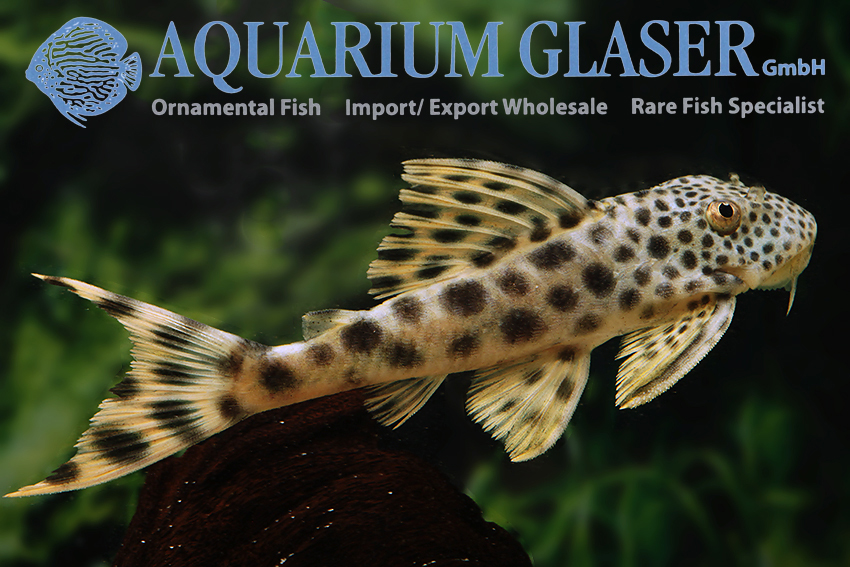
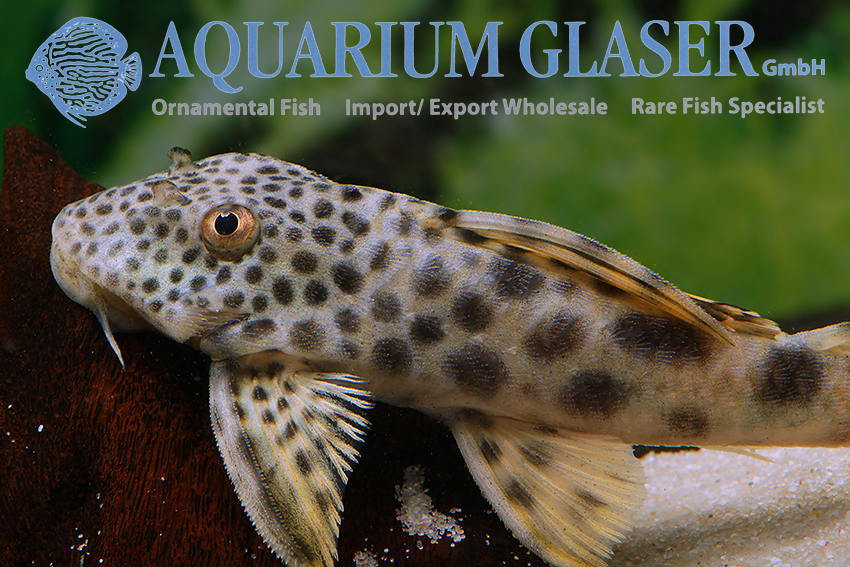
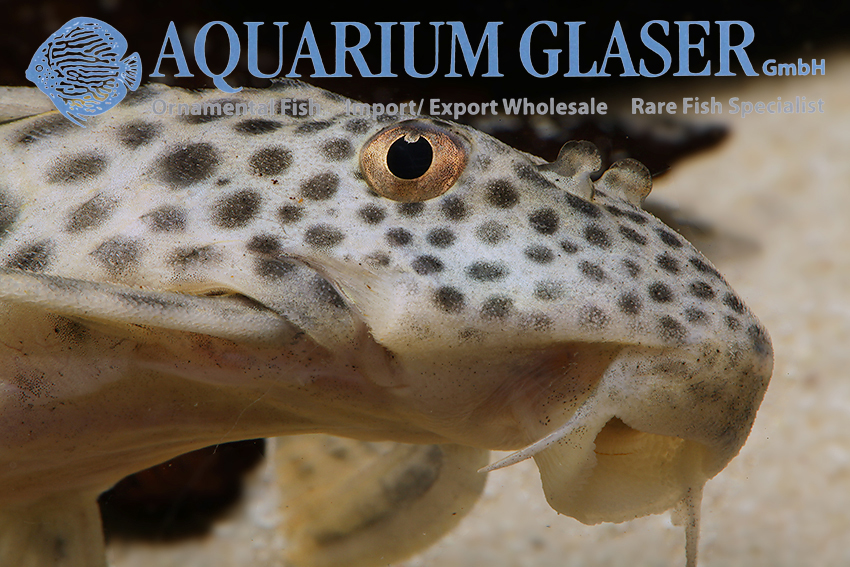
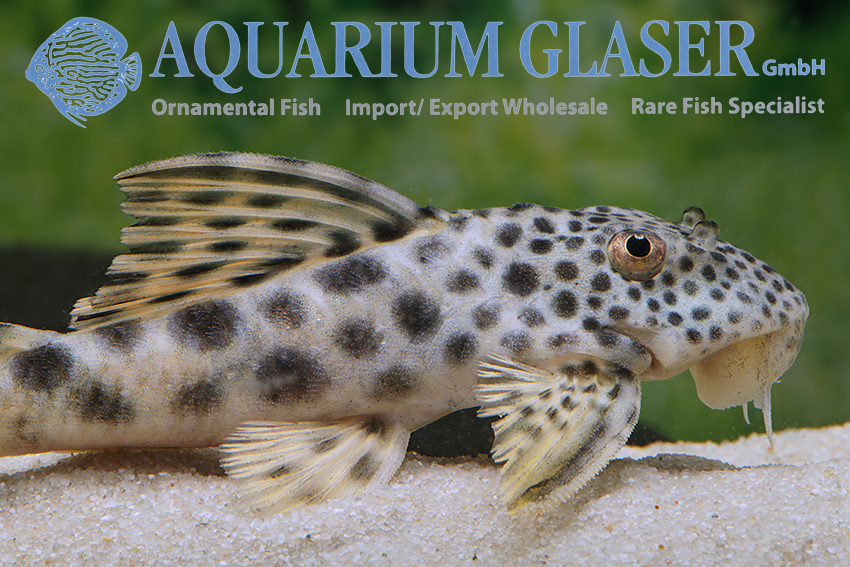
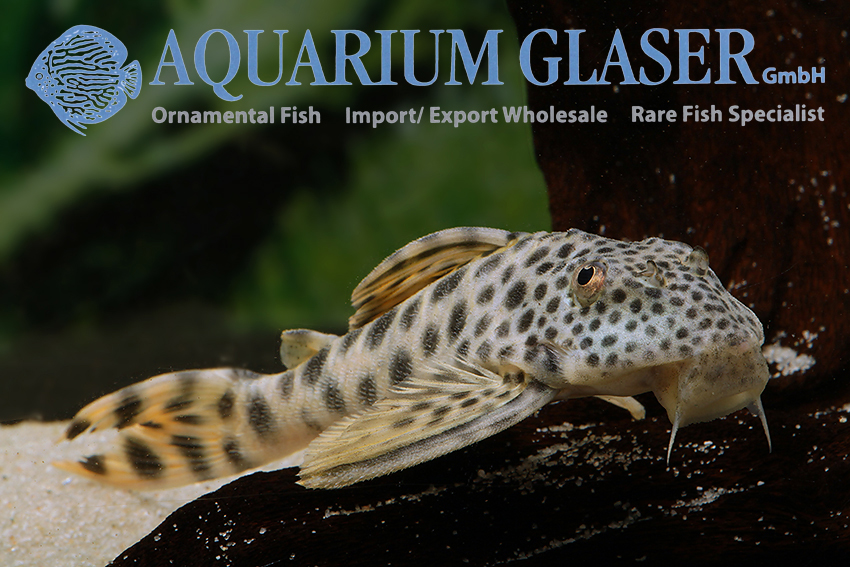
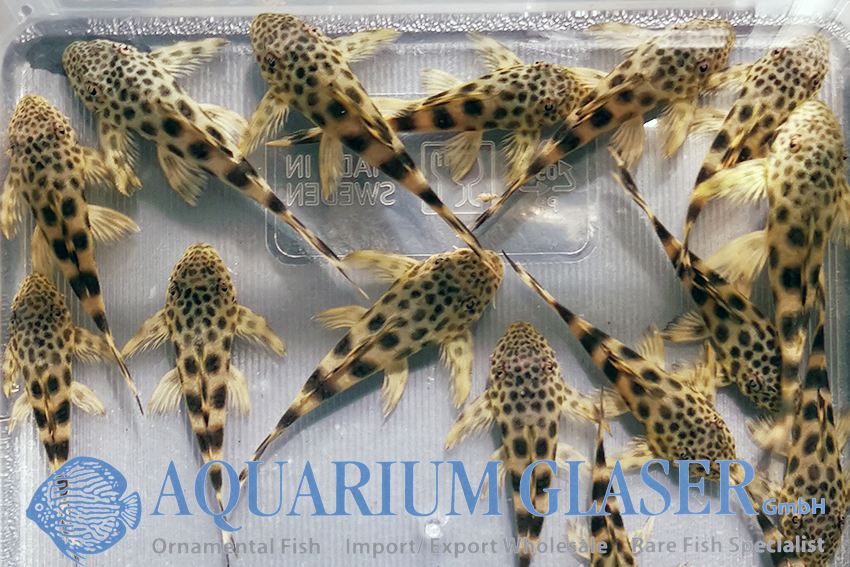
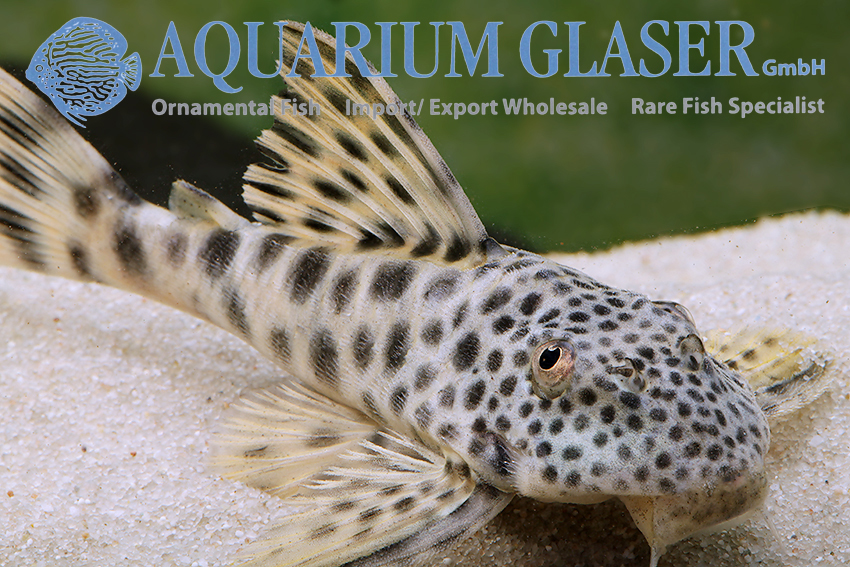
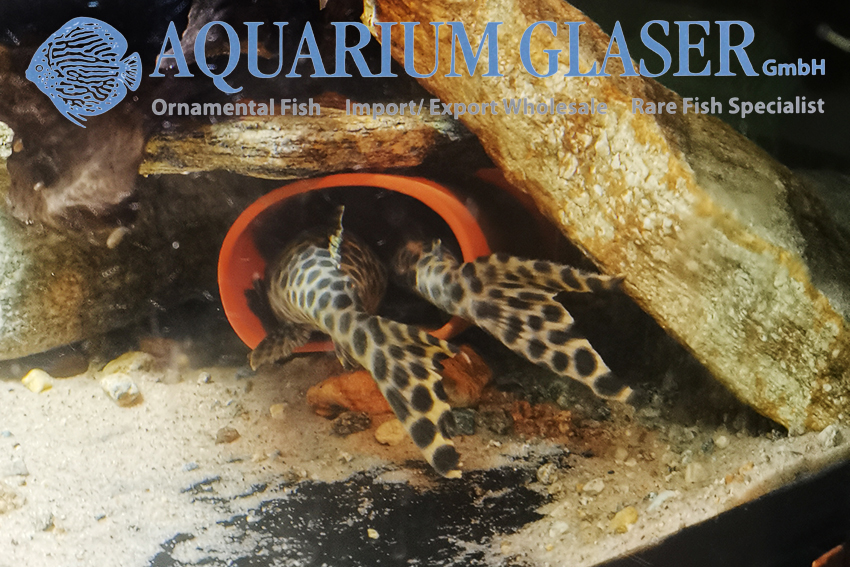
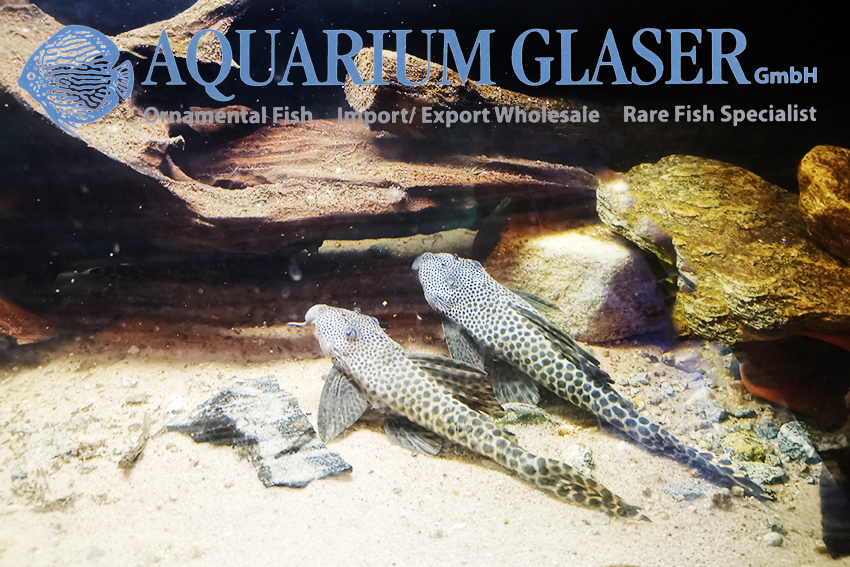
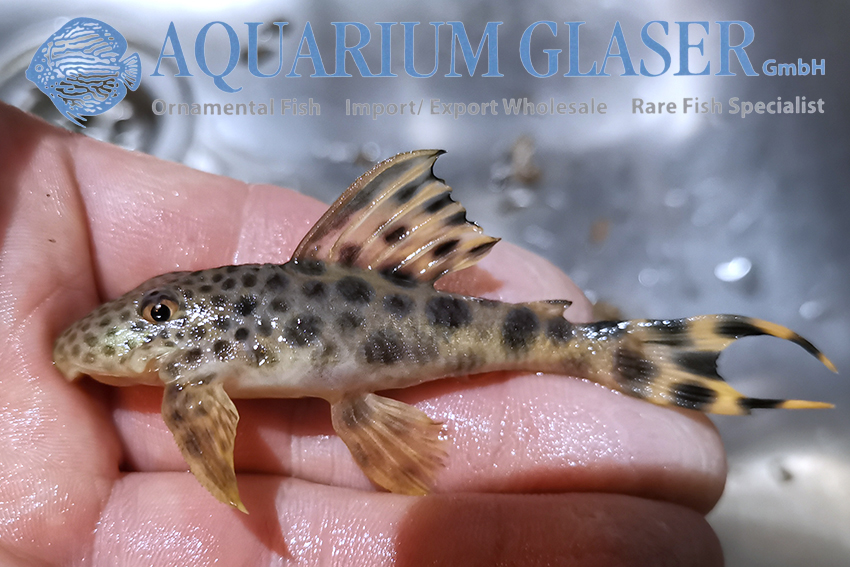
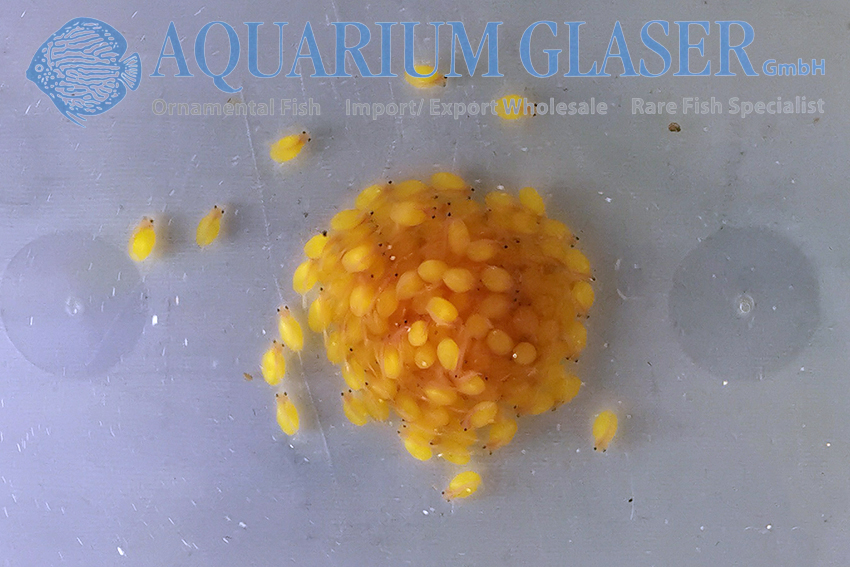
Breeding report Ancistomus cf. sabaji L75
Until breeding L75 was a long way. I tried it for seven years with two groups. It turned out: patience is always the key to success with difficult plecos.
L75 is a pleco that has fascinated me for some time, so I was happy when I got three adults (two males and one female) in 2014. I had no success with this group, but six years later, in 2020, I bought seven more. Things went very quickly with this group. Several of the males showed interest in the caves, and I was happy to soon find one on a large clutch. The fight for the cave with other males stressed the brooding animal quite a bit, and after 3 days he threw the clutch out of the cave.
I managed to recover about fifty eggs, but because of a fungus, only six hatched, all of which fortunately survived. Later I removed four adults, so I ended up with the breeding male and two presumed females. Further reproduction now went very well, with the male mating with both females and taking care of the eggs and young, this time without disturbance.
The adults are 20-25 cm and are fed an insect-based diet with some fresh fish and mussels. Soft, neutral water, 28-30 degrees Celsius. The number of eggs per clutch was 150-250, depending on the size of the female. The fry grow very well on a varied diet under the same conditions, are gray at first and get the leopard pattern at about 3 cm. All in all, due to its more active behavior compared to other plecos, L75 is a very entertaining species whose care and breeding can only be recommended.
Knut Hatteland Sømme
Loricaria lata
From the larger growing, mouthbrooding whiptail catfishes of the genus Loricaria only the very widespread L. simillima is in the trade from time to time, the others – after all there are 17 recognized plus several scientifically still undetermined species – are absolute top rarities. We have now received L. lata from Brazil. This species grows 20-25 cm long. It originates from the drainage of the Rio Tocantins. Like so many mouthbrooding loricariids this species is polychromatic, i.e. within one population there are quite differently marked animals. Our fish also show this polychromatism. Some are almost completely black, others rather bright with black bands and there are all conceivable intermediate stages; depending upon mood the animals also can change color.
Among themselves our fish are peaceful. However, they are somewhat skittish and try to hide in the bottom when disturbed. A sandy bottom is therefore useful for the care, even if the fish then look in the close-up as if they had the white spot disease (Ichthyophtirius). We can reassure you: the animals are perfectly healthy.
For our customers: the fish have code 266563 on our stocklist. Please note that we only supply wholesale.
Text & photos: Frank Schäfer
- 1
- 2
- 3
- 4
- Next Page »





